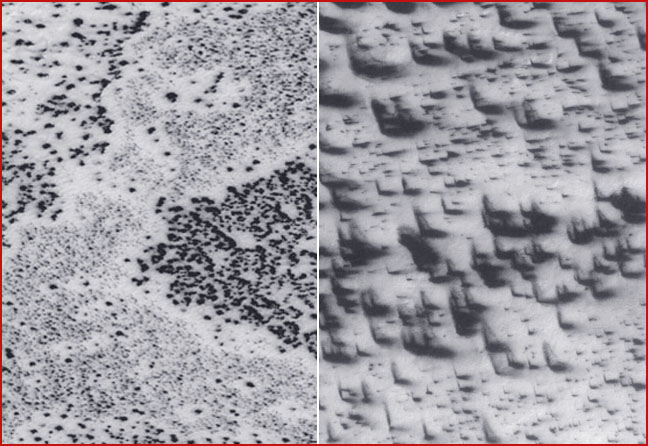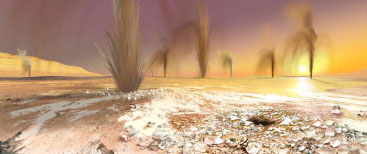
home •
about •
essential guide •
picture of the day •
thunderblogs •
news •
multimedia •
predictions •
products •
get involved •
contact
picture of the day archive subject index
The two images above, both from the Mars Orbiter Camera, suggest a direct relationship between
mysterious dark spots on Martian south polar ice and “geysers” ejecting dark material to
be distributed on the ice. Credit: NASA/JPL/MSSS
May 25, 2007
Mars' South Polar Dark Spots and "Geysers"
It is now known that “geysers” are active on the planet Mars in its southern spring, and there are many reasons to believe that the cause is electrical.In previous installments in this series we have noted several remarkable and unexplained
events and surface features on Mars, all explicable as electrical phenomena:• Hundreds (or more likely thousands) of “dust devils,” in close congregation, feed the billowing clouds of regional dust storms on Mars; these vortices cannot be caused by the mechanics of neutral wind circulation. But as we have observed more than once, it is the fundamental nature of charged particle beams to provoke vortical motion.
• Unexplained ravines run down the south-facing embankment of a massive “sand dune” in Russell Crater, with no evidence of flowing debris, but exhibiting a form that matches the trough cut by a proton beam in a simple electrical experiment.
• Scalloped terrain at the crest of the Russell Crater “dune” suggests a plasma “pinch” of charged particle streams arriving to carve the cleanly cut ravines; the ravines themselves show no evidence for the “landslide” explanation of these alcoves along the dune crest.
• Dark nodules on the back side of the dune crest remind us of the fused blisters on a lightning arrestor, all in strategic alignment with the south-facing ravines; Many of these aligned nodules are joined by mysterious shallow channels suggestive of charge redistribution in response to focused discharge activity.
• Farther to the south, abundant but implausibly aligned dark patches, called “dalmatian spots,” pervade the south polar ice--all consistent with the patterns of aligned electric discharge columns.
Features such as these--and there are many more to be taken into account-- direct our attention to a rational principle you will not hear discussed by NASA’s planetary scientists: when clearly associated features provoke disconnected or incompatible explanations, the explanations are not trustworthy. When the same features match the patterns logically expected from a new theoretical perspective, it is not reasonable to ignore that new vantage point.
If the dark spotting on Mars’ south polar ice is indeed caused by charged particle streams, one of the first things we should look for is an active response of the surface to these events. Since the dark spotting is occurring in the Martian south polar spring, that would be the time to look for signs of energetic activity--not unlike the so-called “volcanic” plumes of Jupiter’s closest moon Io, or the “geysers” of Saturn’s moon Enceladus.
Our image for today compares two conditions seen in the polar region of Mars. On the left we see the dark “dalmatian spots,” known to be associated with a distribution of darkened material across much of the south polar ice cap. On the right is a complex of features known to be involved in the creation of dark spots. In recent years NASA has released several stories discussing the activity of Martian south polar “geysers” (see NASA artist rendering below) and offering highly speculative explanations for them.
As strange as it may seem, however, NASA scientists do not see geysers in such images, only the darkened “wind streaks” left by geysers. In fact, to the best of our knowledge, while NASA scientists speculate frequently about south polar geysers and their resulting “wind streaks,” no one employed by NASA has ever claimed to have witnessed a geyser in action.
In the large library of south polar images, accumulated over the past ten years, there is indeed a great potential for confusion between enigmatic dark streaks on the south polar terrain and the active events (“geyser”) that create them. Yet in this particular instance, the picture itself removes any doubt, since the erupting material can be seen falling back to the surface. We are not simply looking at dark streaks on the surface, as NASA spokesman have repeatedly claimed.
It is a bit curious that the NASA illustration of conjectured geysers (below) looks remarkably similar to the plumes in this very MOC image. Perhaps the artist did look at pictures of active geysers. But in recent years we have found that NASA scientists spend very little time scrutinizing the wealth of Martian images, and far too much time conjuring theoretic models and simulations to defend “acceptable” interpretations-- even when the pictures themselves categorically exclude these speculations.
NASA’s explanation of south polar “geyser” activity will provide a good example, which we shall take up next. While the imaging technology is superb, the organization’s widely publicized theory fails every reasonable test.
Next in this series: Martian “Geysers”--Still Unexplained
![]()
home •
thunderblogs •
forum •
picture of the day •
resources •
team •
updates •
contact us
EXECUTIVE EDITORS:
David Talbott, Wallace Thornhill
MANAGING EDITORS:
Steve Smith, Mel Acheson
CONTRIBUTING EDITORS: Michael Armstrong, Dwardu Cardona,
Ev Cochrane,
C.J. Ransom, Don Scott, Rens van der Sluijs, Ian Tresman
WEBMASTER: Brian Talbott
Copyright 2007: thunderbolts.info

